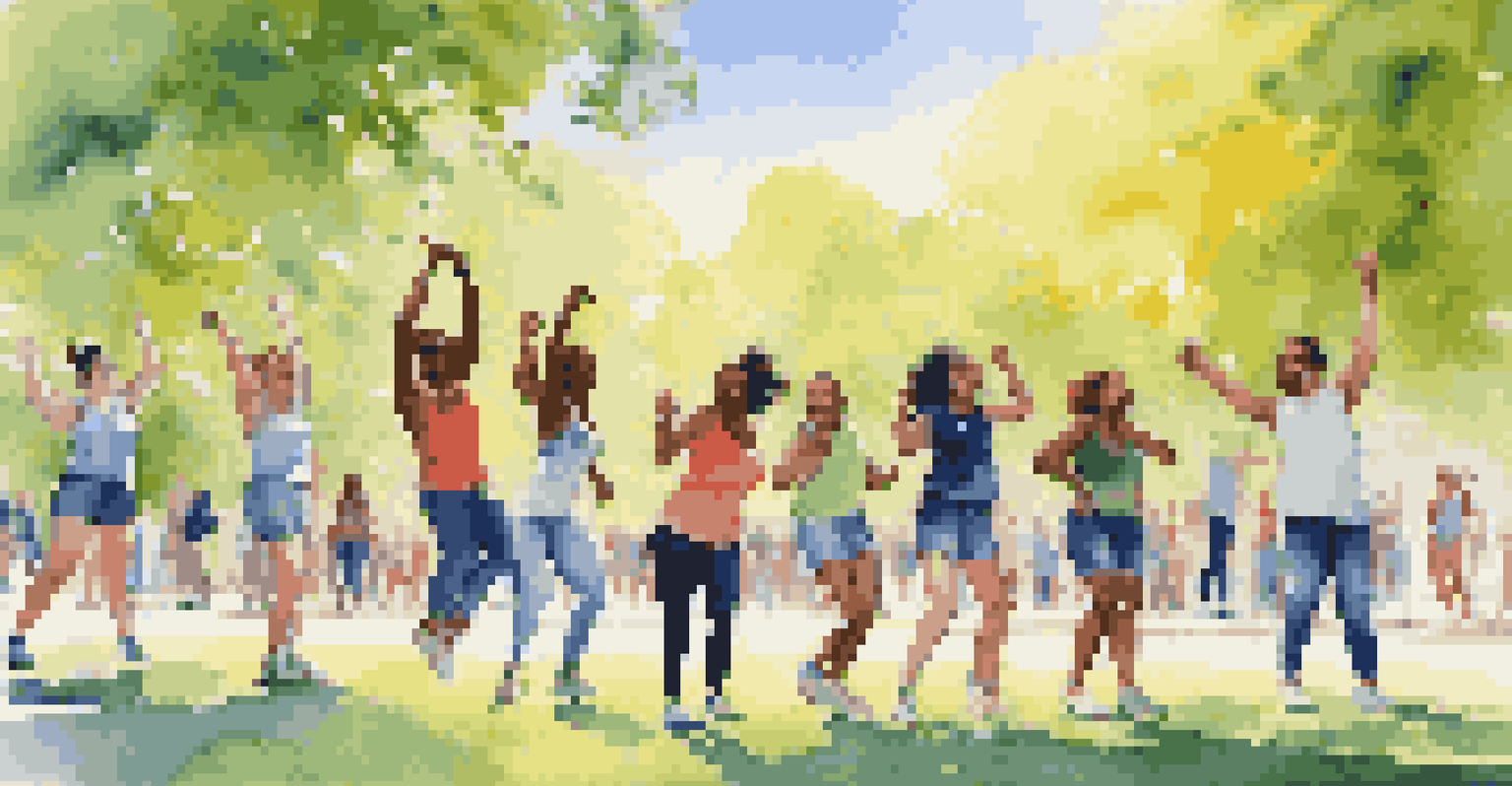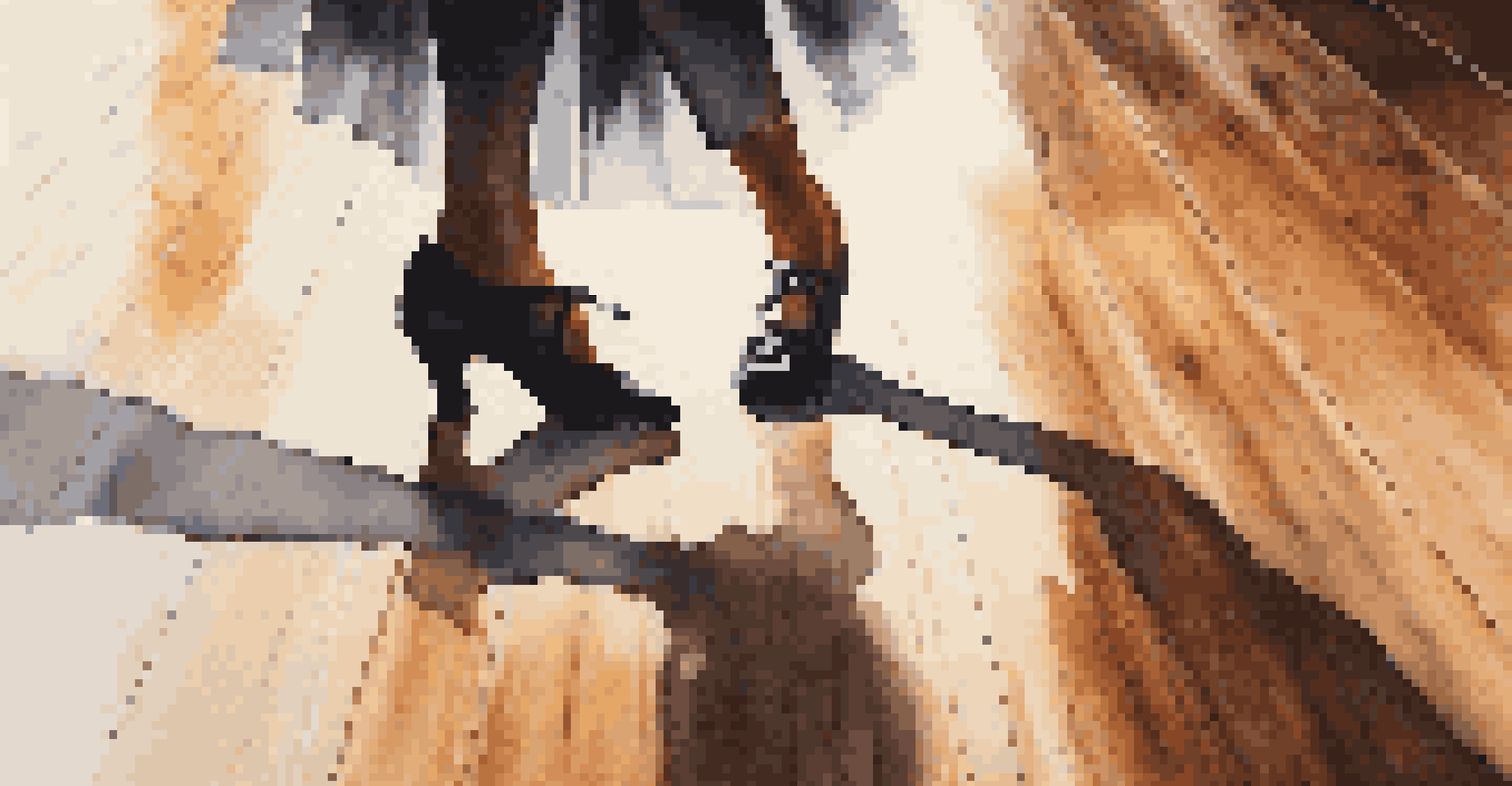Social Dance in the Digital Age: Online Communities and Trends

The Evolution of Social Dance in a Digital World
Social dance has undergone a remarkable transformation in the digital age. Once limited to physical gatherings, dance has found a new home online, creating opportunities for people to connect regardless of geographic boundaries. Platforms like Instagram and TikTok have given rise to viral dance challenges, allowing dance enthusiasts to share their moves with a global audience.
Dance is the hidden language of the soul.
These online platforms serve not only as stages but also as classrooms, where anyone can learn new dance styles from the comfort of their homes. This accessibility has democratized dance education, making it easier for individuals to explore different genres without the pressure of a live audience. As a result, social dance is now more inclusive than ever, welcoming diverse backgrounds and skill levels.
Moreover, the fusion of technology and dance has encouraged innovative expressions. Dancers are now experimenting with virtual reality and augmented reality, creating immersive experiences that blend the physical and digital realms. This evolution is reshaping how we perceive and engage with social dance, making it a dynamic and evolving art form.
Online Communities: Building Connections Through Dance
The rise of social media has fostered vibrant online communities centered around dance. These virtual spaces allow individuals to connect, share experiences, and support each other in their dance journeys. From Facebook groups to dedicated dance forums, these platforms create a sense of belonging for dancers, regardless of their skill level.

In these communities, members exchange tips, tutorials, and feedback, fostering a culture of collaboration. For instance, a novice dancer can post a video of their progress and receive constructive advice from seasoned dancers across the globe. This synergy not only enhances individual skills but also strengthens community ties, creating lasting friendships.
Digital Dance Communities Flourish
Online platforms foster vibrant dance communities, allowing individuals to connect, share experiences, and support one another regardless of skill level.
Additionally, online events such as virtual dance battles or live-streamed workshops have made it possible for dancers to showcase their talent and learn from industry professionals. These events break down barriers, allowing anyone with an internet connection to participate and experience the joy of dance, further solidifying the bond within these communities.
Influencers and the Impact on Dance Trends
Dance influencers play a pivotal role in shaping current trends within the social dance scene. With their large followings, these individuals can introduce new styles and challenges that quickly gain traction. For example, a simple dance challenge on TikTok can spark a viral movement, inspiring countless users to join in and create their versions.
The dance is a poem of which each movement is a word.
This influence extends beyond mere choreography; it often includes fashion, music, and cultural elements that resonate with audiences. As influencers share their unique interpretations, they encourage followers to embrace creativity and authenticity in their dance. This trend-driven environment keeps the dance community fresh and exciting, as new styles continuously emerge.
However, it’s essential to recognize the responsibility that comes with this influence. Dancers and influencers alike must promote inclusivity and respect for the origins of different dance styles. This awareness not only enriches the dance culture but also ensures that it remains respectful of its roots while evolving in a modern context.
Virtual Dance Classes: Learning in a New Era
With the advent of online platforms, virtual dance classes have become a popular alternative to traditional in-person lessons. These classes offer a plethora of options, from ballet to hip hop, making it easy for anyone to find a style that suits their preferences. Not only do they provide flexibility in scheduling, but they also eliminate the need for travel, making dance accessible to a broader audience.
Instructors are leveraging technology to create engaging and interactive experiences for students. Many classes incorporate real-time feedback through video calls or utilize platforms that allow for group interactions. This environment encourages participation and camaraderie, mirroring the dynamics of in-person classes.
Technology Enhances Dance Learning
Virtual dance classes offer flexible learning options and access to diverse instructors, making dance education more accessible than ever.
Moreover, virtual dance classes often feature guest instructors from around the world, providing students with diverse perspectives and techniques. This exposure enhances the learning experience, as students can absorb various styles and approaches to dance that they might not encounter locally.
The Role of Technology in Dance Creation
Technology is not just a tool for learning; it also plays a crucial role in the creation of new dance works. Choreographers are now using software to visualize and plan their routines, allowing them to experiment with movements before hitting the stage. This process can lead to innovative performances that push the boundaries of traditional dance.
Additionally, digital platforms enable the collaboration of artists from different disciplines. Dancers can work alongside musicians, visual artists, and filmmakers to create multimedia performances that captivate audiences. This cross-pollination of ideas enriches the artistic landscape, resulting in unique and thought-provoking works.
As technology continues to evolve, so too will the possibilities for dance creation. Whether it's through motion capture, interactive installations, or even AI-generated choreography, the future of dance is ripe with potential, inviting artists to explore uncharted territories.
Social Dance and Mental Health: A Digital Support System
The past few years have highlighted the importance of mental health, and social dance can play a significant role in this aspect. Engaging in dance, whether online or offline, provides a creative outlet for self-expression and stress relief. Virtual dance communities have become a source of support for individuals navigating challenges, offering a space to share experiences and uplift one another.
Online dance classes and workshops also promote physical activity, which is essential for mental well-being. Many participants find that dancing not only boosts their mood but also enhances their overall health. The combination of movement and social interaction creates a positive feedback loop that benefits mental health.
Mental Health Benefits of Dance
Social dance serves as a vital support system for mental health, providing a creative outlet and fostering a sense of belonging in online communities.
Furthermore, the sense of accomplishment from learning new dance moves or participating in group challenges can greatly enhance self-esteem. As people connect over their shared love of dance, they cultivate a supportive environment that encourages personal growth and resilience, showcasing the powerful impact of social dance in the digital age.
The Future of Social Dance: Trends to Watch
As we look ahead, several trends are poised to shape the future of social dance in the digital realm. One significant trend is the continued integration of technology, which will likely lead to more immersive experiences. Whether through virtual reality dance parties or innovative online competitions, the possibilities for engagement are boundless.
Another trend is the emphasis on inclusivity and representation within the dance community. As more individuals share their diverse backgrounds and styles, the narrative around social dance continues to broaden. This shift promotes a richer dance culture that celebrates various influences and embraces creativity in all forms.

Lastly, we can expect a growing focus on mental health awareness within dance communities. As the connection between movement and well-being becomes increasingly recognized, more initiatives will arise to support dancers emotionally and physically. This holistic approach to social dance will ensure that it remains a source of joy, connection, and growth for everyone involved.